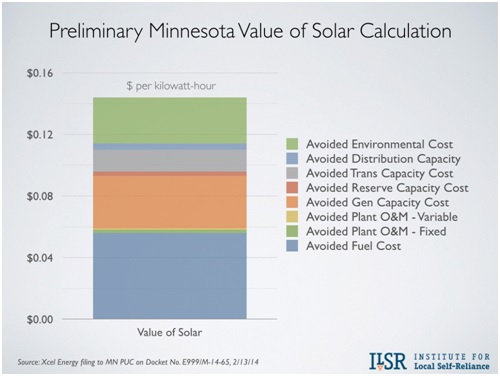Market trend
ASTI Newsletter | April 2014 Edition | By Eileen Hays
Solar energy’s consumer benefits are well recognized, from long-term financial savings and energy independence to economic development and a cleaner environment. The gains utilities receive from distributed solar electricity production are perhaps less obvious. Not having to transmit power to and from centralized power plants saves them money in avoided generation costs, and distributed solar also assists utilities with meeting environmental mandates without having to make direct investments. As a result, state regulators and utilities across the country have began to pose the same question: what is the best way to calculate the value of solar?
In 43 states, solar energy producers can receive credit for the excess power they put back onto the grid from their panels at the full retail rate of electricity. Exactly as the name implies, net metering allow utilities to charge for the net difference in electricity consumption on a monthly basis by having the electricity meter roll backwards as solar power is produced. This policy has been vital to the growth of the residential and commercial PV market in booming solar states from California to New Jersey.
However, critics of net metering argue that the current model is unfair, as it shifts grid infrastructure and service costs to non-solar utility customers. These costs are built into the electricity price customers consume from the grid, and therefore are not paid by solar customers. Net metering advocates, on the other hand, explain that this argument it is rooted in politics rather than factual “cost shifts.” In an effort to quell the debate, several states and utilities are re-evaluating their net metering policies and exploring other mechanisms for compensating solar producers.
One method that has received national attention lately credits solar panel owners for the power they produce at a long-term, fixed value of solar rate. In contrast to net metering in which value is tied to retail electric rates, the value of solar tariff (VOST) is an independently derived rate that the utilities pay for the entirety of the solar power produced. The customer is also billed for 100% of their total electricity usage at the retail rate. This approach has the added benefit of improving the value of energy efficiency upgrades that otherwise might not be cost-effective if a consumer’s bill was minimized through solar deployment.
As long as the VOST is high enough relative to the amortized cost to install a PV system, there is still a financial incentive to go solar. However, the degree of impact hinges upon the formula used to determine the value of solar. The hope is that right balance will be found where the tariff is high enough to capture the added benefits, and that utilities and non-solar ratepayers do not bear the burden of shifted service costs. The following are two examples where VOST has been implemented.
Austin Energy
As a long-time supporter of solar PV, Austin Energy wanted to find a way to quantify the additional benefits that solar energy provided to the Texas state capitol. The utility derived a formula from various analyses – including PG&E, Sandia Labs, and Clean Power Research among others – on the value to Austin in order to create the first VOST for its customers. Ultimately, the rate was based upon several key values:
- Energy value
- Generation value
- Environmental value
- Transmission and distribution system value
- Disaster recovery value
- Reactive power value
- Loss savings value
The program change began October 2013, completely replacing net metering. Now the utility pays solar PV customers a VOST of 12.8 cents/kWh for all of the electricity they produce, while still billing for the total electricity they consume at the same rate as all other ratepayers. The billing rate ranges between 1.8 – 11.4 cents/kWh, based on seasonal adjustment and multiple user tiers, in addition to a $10 monthly Customer Charge.
Minnesota State
Last March, Minnesota legislators passed a bill to give its utilities the option to use a VOST instead of net metering, becoming the first state in the nation to institute such a measure. Proponents of the policy argue that VOST will be a better quantification of the value of solar power to utilities, society and the environment. According to John Farrell at the Institute of Local Self-Reliance, utilities will be better off in the long-term with VOST due to the reliable purchase rate for solar power, while avoiding ratepayer subsidies to solar customers. He also argues that that the certainty of rates over 25 years will help new solar adopters with cheaper financing.
The formula for determining the “right” VOST is undergoing rulemaking to address concerns from various stakeholders. Preliminary estimates from Xcel Energy, Minnesota’s largest investor-owned utility, have the VOST rate at 14.5 cents/kWh, about 3 cents/kWh more than the retail rate. The forecasted breakdown of the VOST is provided below.
As an alternative to net metering policies, VOST is currently being evaluated for its impact on solar deployment. Though the verdict is still out on the most effective solar policy, deployment will still largely depend on the total cost of installing a new solar system.




